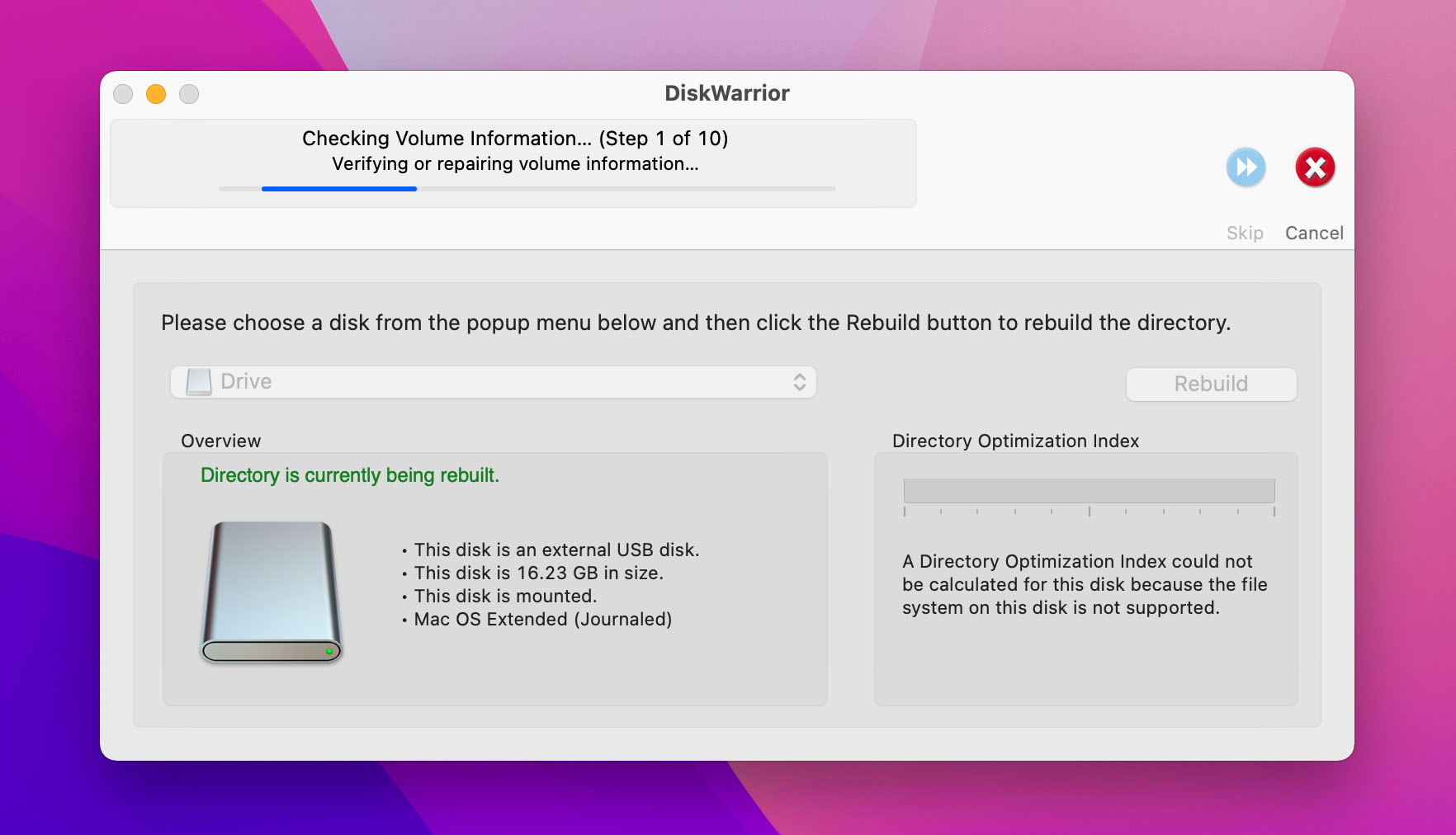

A moment later, I had a new directory and clean, green bill of health. After six minutes, DiskWarrior notified me that it had "successfully built a new optimized directory." I clicked Replace and hoped for the best. I clicked the Rebuild button and watched the utility glide through ten steps. The Directory tab includes a color-coded optimization index: green indicates that a directory is not fragmented yellow suggests it's inefficient and red indicates serious issues. My directory, on the other hand, needed work. Fortunately, no major problems were found. The test required about four minutes, after which DiskWarrior indicated that it had verified and repaired my permissions, checked the property list of 3,316 files, and checked the resource data of 2,847 files. I used the Files tab to correct my permissions and scan my files and folders for issues. S.M.A.R.T diagnostics, in the Hardware tab, reassured me that nothing was wrong with my three-year-old SSD. I tested DiskWarrior's three main functions. Thankfully, DiskWarrior lets you disable the feature by clicking an unlock button and entering a FileVault password.

I discovered that this was because I had enabled FileVault, which encrypts data. When I booted into DiskWarrior, my drive registered as locked. This hiccup gave me the opportunity to create my own bootable drive using the latest version of DiskWarrior Recovery Maker (v1.1), a three-minute process. The version of DiskWarrior included on my flash drive wasn't compatible with my operating system ( macOS Sierra ). I encountered two additional, but easily resolvable, issues. It took me longer than I care to admit to realize I had forgotten to include the forward slash before Volumes. It's important that to enter that command exactly: add a space or lose a slash and DiskWarrior won't launch. You must boot into the Recovery partition (you hold down the R key), launch the Terminal (from the Utilities menu), and enter a command into the prompt (/Volumes/DW/go). Since Apple released its Recovery partition (with OS X 10.7), the process has become more complicated. (You can also create your own using a 2GB flash drive.) If your system is running OS 10.6 or earlier (preinstalled on Macs prior to 2011), you can boot directly off the drive by holding down the Option key. Now that Apple has largely jettisoned disk drives, Alsoft ships the utility on a flash drive.


If a disk is mechanically failing, DiskWarrior lets you repair your Mac's directory and back up its data before you replace the drive. Repairing a directory can make files and partitions reappear, improve performance, and even recoup disk space. Given that a directory contains millions of data points, the process is simpler in theory than practice. Unlike other utilities that attempt to repair problems in the existing directory, DiskWarrior creates a new directory. DiskWarrior rebuilds that file system using existing data.
#Diskwarrior 5 review software
Defective RAM, power glitches, and poorly-written software can throw that table of contents into disorder.Īs a senior Alsoft technician explained it, Apple's file system (HFS+) is a complicated animal. DiskWarrior is designed to scan, maintain, and repair the directory, which you can think of as a table of contents. In the current version, the method has changed, but not the aim. Reviewing a previous version of the utility, we described DiskWarrior as almost singularly focused on rebuilding damaged directories.
#Diskwarrior 5 review mac
While Prosoft Data Rescue 4 ($99.00 at Prosoft) can scan disks to recover lost or deleted files, DiskWarrior is unrivaled in its ability to repair and rebuild the Mac directory. That includes utilities from Apple, whose Disk Utility may be suitable for basic maintenance and partition, but remains ill-prepared to repair badly damaged directories that result in kernel panics and boot failures. While Alsoft has updated the utility and adopted flash storage over the past 18 years, DiskWarrior continues to perform maintenance and recovery tasks that no other utility can do. I've been using the $119 DiskWarrior to perform routine maintenance and to resurrect defunct Macs since it shipped on a CD. In fact, Alsoft DiskWarrior is one of the best utilities you can buy for your Mac. Today, the utility is no less useful for a swivel-neck iMac or a MacBook with a solid-state drive (SSD). In fact, that isn't entirely true: Apple once bundled the third-party utility with AppleCare.


 0 kommentar(er)
0 kommentar(er)
